高中英语人教新课标必修四unit 4 Body language reading课件 (共20张PPT)
文档属性
| 名称 | 高中英语人教新课标必修四unit 4 Body language reading课件 (共20张PPT) |  | |
| 格式 | zip | ||
| 文件大小 | 2.9MB | ||
| 资源类型 | 教案 | ||
| 版本资源 | 人教版(新课程标准) | ||
| 科目 | 英语 | ||
| 更新时间 | 2018-12-05 07:45:37 | ||
图片预览


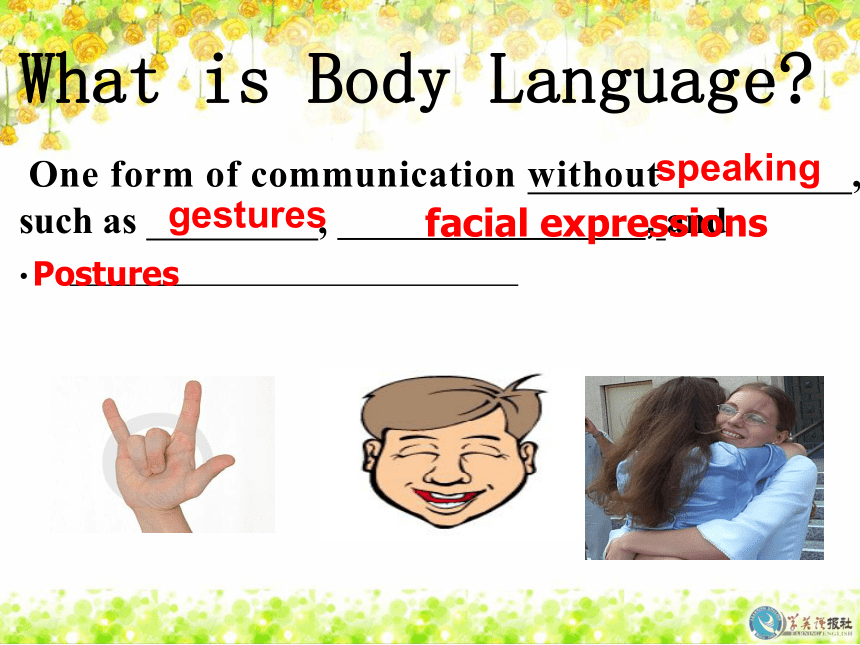

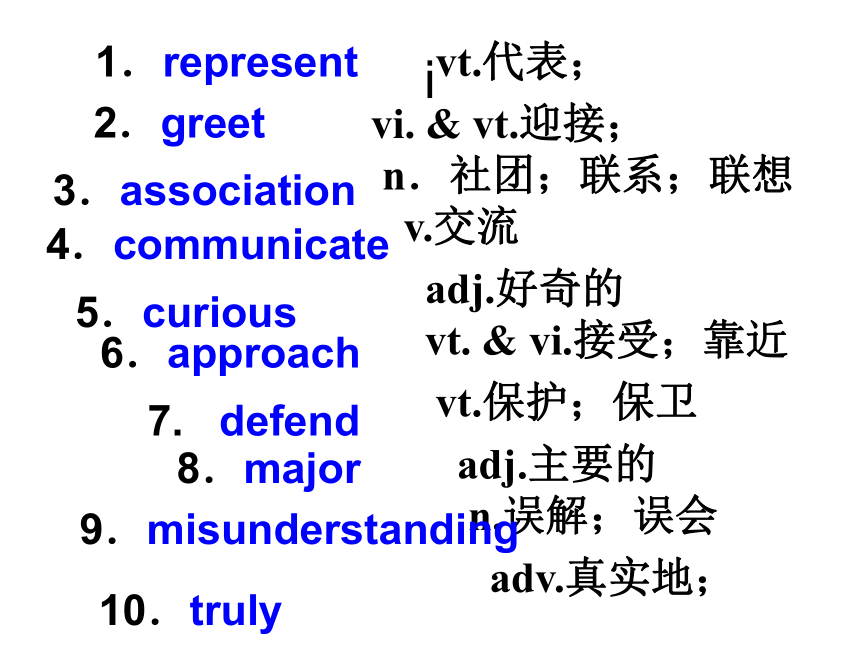

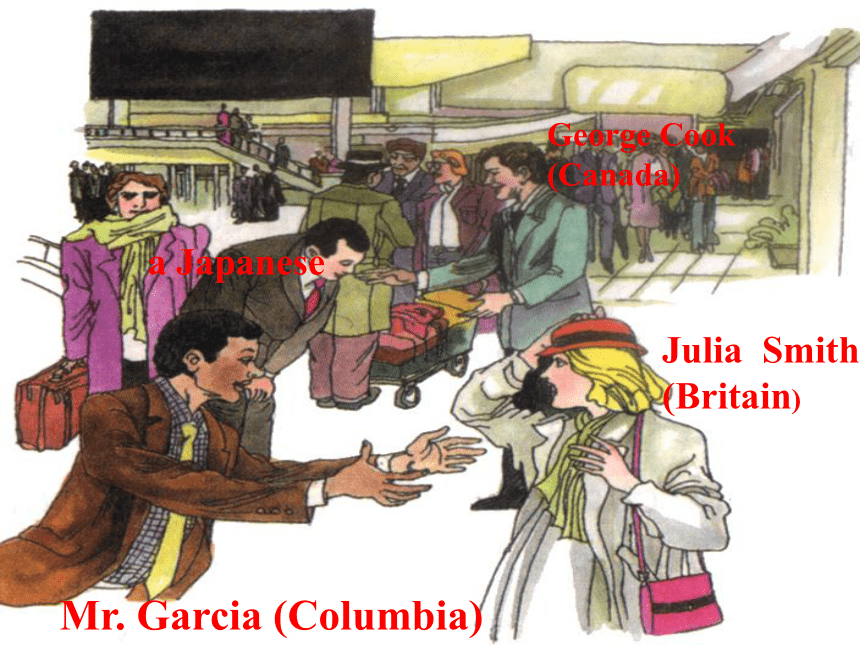
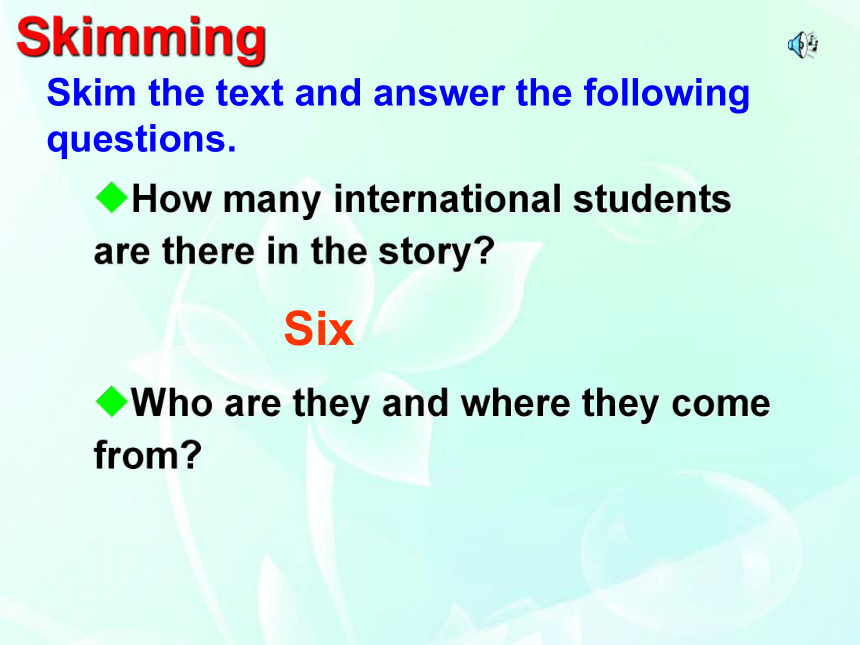
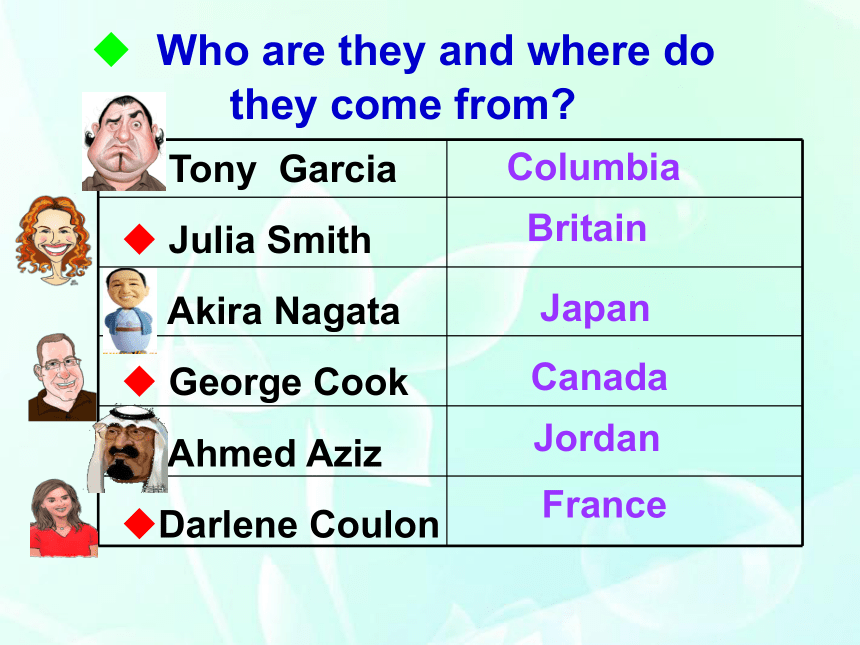
文档简介
课件20张PPT。WELCOMEBody languageWhat is body language ?Let’s review !What is Body Language? One form of communication without , such as , , and . facial expressionsPosturesspeakinggestures_______________: No Problem?Reading Page26Communicationi vt.代表;
vi. & vt.迎接; n.社团;联系;联想 v.交流
adj.好奇的 vt. & vi.接受;靠近
vt.保护;保卫
adj.主要的 n.误解;误会
adv.真实地; 1.represent2.greet 3.association 4.communicate 5.curious 6.approach7. defend 8.major 9.misunderstanding 10.truly
昨天我 代表 东江中学去 迎接 英国的一个 社团 到我们学校
交流, 出于 好奇
我们 靠近 他们,但同时由于潜意识地 保护 自己,我们出现了 主要 的 误会 。 这是真实 发生的。representgreetassociationcommunicatecuriosityapproachdefendmajormisunderstandingtrulyededed Mr. Garcia (Columbia)Julia Smith (Britain)George Cook (Canada)a JapaneseSkimmingHow many international students are there in the story?
Who are they and where they come from?Skim the text and answer the following questions.Six Who are they and where do they come from? Tony Garcia
Julia Smith
Akira Nagata
George Cook
Ahmed Aziz
Darlene Coulon ColumbiaBritainJapanCanadaJordan France
C) You are sent to the Capital Airport to meet international students.A) Summary of body language.B) Different people have different body languages. D) Examples of cultural “body language”.(Para1)(Para 2 and 3) (Para 4 )(Para5)Part 1 :Part 2:Part 3:Scan the passage to check if you are right ,and match the main idea of each part.
Part 4: Do all members of all cultures behave the same way ?
No, they don’t.Para2: Find out the two cultural mistakes the author found at the airport:Tony Garcia Julia SmithThe first cultural mistakefromfrom(Columbia )(Britain)He approached Julia , _______ ______ _________ and _______ her on the ________.She ______ ________ appearing _________ and put up her hands, as if in _________.shouldertouchedherkissedcheekstepped backsurpriseddefenceThe second
cultural
mistakeAkira Nagata
fromGeorge Cookfrom(Canada)He ________ ________ _______ ________ to the Japanese.He ________ to Mr. Cook and his nose _________ George’s _______ ________.bowedtouchedmovinghandreached his handout(Japan)Mr Garcia (Columbia)
Julia Smith (Britain)
Visitor (Japan)
George Cook (Canada)
Madame Coulon (France)Matching the people and their different ways of greeting shakes hands and kisses others twice on each cheek
bows
shakes hands
approaches others closely and touches their shoulder and kisses them on the cheek
does not stand very close to others or touch strangers(para2&3)
Part 2true (T) or false (F) and correct the error. 1.Englishmen often stand close to others or touch strangers as soon as they meet.
2.Most people around the world now greet each other by kissing .
3.Japanese will bow to others as greeting.
4.People from Jordan will move very close to you as you introduce yourself to them.
5.Some body languages in some countries are good while some countries’ body language are bad.part4(para5)Post-readingTask : discussionUse the passage to help you answer the
following questions.1 Is the author of this passage male or female? How do you know?
2“ When in Rome, do as the Romans do.” What do you think this famous saying means?
1 Is the author of this passage male or female? How do you know? male.
Ahmed Aziz did not shake hands
with women, but he shook with
the author.2“ When in Rome, do as the Romans do.” What do you think this famous saying means? when we are in a certain place, we should follow the customs there, not our own .______language is __________ from culture to ________. Not all ________of a culture ________in the ______ way.In general, _________ international customs can certainly help ________ difficulties in the cultural communication.Bodydifferentculturemembersbehavesame studyingavoidSummary
vi. & vt.迎接; n.社团;联系;联想 v.交流
adj.好奇的 vt. & vi.接受;靠近
vt.保护;保卫
adj.主要的 n.误解;误会
adv.真实地; 1.represent2.greet 3.association 4.communicate 5.curious 6.approach7. defend 8.major 9.misunderstanding 10.truly
昨天我 代表 东江中学去 迎接 英国的一个 社团 到我们学校
交流, 出于 好奇
我们 靠近 他们,但同时由于潜意识地 保护 自己,我们出现了 主要 的 误会 。 这是真实 发生的。representgreetassociationcommunicatecuriosityapproachdefendmajormisunderstandingtrulyededed Mr. Garcia (Columbia)Julia Smith (Britain)George Cook (Canada)a JapaneseSkimmingHow many international students are there in the story?
Who are they and where they come from?Skim the text and answer the following questions.Six Who are they and where do they come from? Tony Garcia
Julia Smith
Akira Nagata
George Cook
Ahmed Aziz
Darlene Coulon ColumbiaBritainJapanCanadaJordan France
C) You are sent to the Capital Airport to meet international students.A) Summary of body language.B) Different people have different body languages. D) Examples of cultural “body language”.(Para1)(Para 2 and 3) (Para 4 )(Para5)Part 1 :Part 2:Part 3:Scan the passage to check if you are right ,and match the main idea of each part.
Part 4: Do all members of all cultures behave the same way ?
No, they don’t.Para2: Find out the two cultural mistakes the author found at the airport:Tony Garcia Julia SmithThe first cultural mistakefromfrom(Columbia )(Britain)He approached Julia , _______ ______ _________ and _______ her on the ________.She ______ ________ appearing _________ and put up her hands, as if in _________.shouldertouchedherkissedcheekstepped backsurpriseddefenceThe second
cultural
mistakeAkira Nagata
fromGeorge Cookfrom(Canada)He ________ ________ _______ ________ to the Japanese.He ________ to Mr. Cook and his nose _________ George’s _______ ________.bowedtouchedmovinghandreached his handout(Japan)Mr Garcia (Columbia)
Julia Smith (Britain)
Visitor (Japan)
George Cook (Canada)
Madame Coulon (France)Matching the people and their different ways of greeting shakes hands and kisses others twice on each cheek
bows
shakes hands
approaches others closely and touches their shoulder and kisses them on the cheek
does not stand very close to others or touch strangers(para2&3)
Part 2true (T) or false (F) and correct the error. 1.Englishmen often stand close to others or touch strangers as soon as they meet.
2.Most people around the world now greet each other by kissing .
3.Japanese will bow to others as greeting.
4.People from Jordan will move very close to you as you introduce yourself to them.
5.Some body languages in some countries are good while some countries’ body language are bad.part4(para5)Post-readingTask : discussionUse the passage to help you answer the
following questions.1 Is the author of this passage male or female? How do you know?
2“ When in Rome, do as the Romans do.” What do you think this famous saying means?
1 Is the author of this passage male or female? How do you know? male.
Ahmed Aziz did not shake hands
with women, but he shook with
the author.2“ When in Rome, do as the Romans do.” What do you think this famous saying means? when we are in a certain place, we should follow the customs there, not our own .______language is __________ from culture to ________. Not all ________of a culture ________in the ______ way.In general, _________ international customs can certainly help ________ difficulties in the cultural communication.Bodydifferentculturemembersbehavesame studyingavoidSummary
同课章节目录
